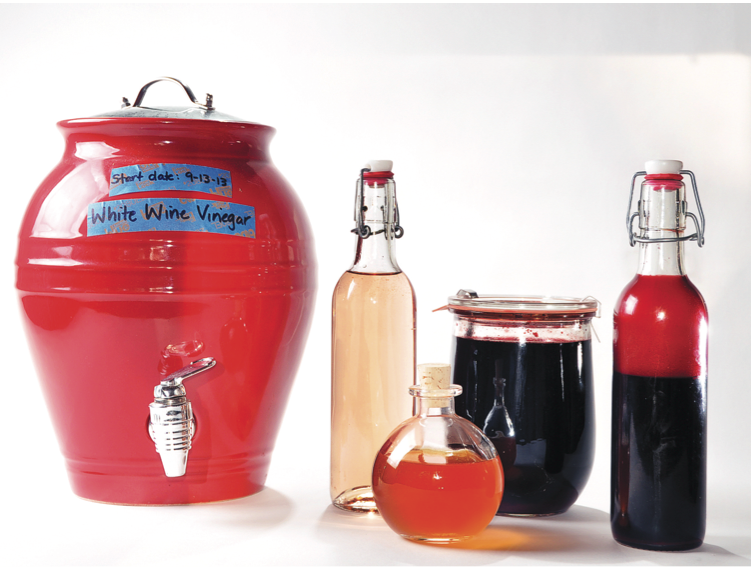Living with the "Mother": Homemade Vinegars
Making a living as a wine merchant definitely has its perks. Perhaps one of the best fringe benefits is a glut of free wine samples. You can file this under the category of It’s a Tough Job But Someone Has to Do It. We only purchase wine at our store after evaluating it ourselves because wine is a living, breathing entity which is constantly changing—not only from vintage to vintage, but as the wine matures and transforms in the bottle as it ages.
Just as in life, wine has its stages. There’s a time when wine is immature and dumb, and best left alone in the corner to brood. Then there’s a fascinating period when wine reaches its true potential and it pinnacles and peaks, a splendor worthy of capturing the attention of both the mind and the soul. This is followed by a stage of slow and inevitable decline before eventually succumbing to death. This life cycle is a veritable roller coaster for collectors, filled with joy and sorrow, not to mention poignancy as it echoes and mirrors our very existence.
As a wine merchant I’ve evaluated wine in every one of these stages, and if I’m frank it’s usually on a daily basis. When an importer brings us several cases of wine to evaluate, we thoughtfully swirl and slurp and (shock!) spit. If we didn’t, the local AA chapter would be filled to the brim with wine retailers. This is a job, after all, and there’s work to be done. Much to the astonishment and horror of outsiders, we usually pour the remaining bottles of wine down the drain, even though only an inch or two were taken from the bottle. We simply don’t know enough people to whom to gift this super excess abundance of wine. And, no, you wouldn’t be the first one to suggest we really should get out more often. Regardless, this waste always bothered us, until one day an old article from Sunset magazine changed everything.
We no longer pour excess wine down the sink. Instead, we transform it into homemade white, red and rosé wine vinegar of startling quality and complexity. If you’ve never tasted homemade vinegar it’s remarkably fresh and vibrant, even downright punchy with an in- your-face attitude. In one word, it’s sensational. We’re now serious homemade vinegar converts, and you may be too, once you realize how simple it is to make at home.
In order to make homemade vinegar you need just two things: a good mother and a regular supply of wine to keep her happy (note, this works in real life too). The mother in this case is actually a live starter that transforms wine into acetic acid via secondary fermentation of bacteria. You can purchase a mother online or grab a hunk from a vinegar-making friend. Don’t worry. Vinegar mothers are surprisingly similar to livers. Cut them and they grow back like magic.
There are both white and red wine mothers. Either can be used to make rosé wine vinegar. For our first experiment we chose two white mothers and one red mother to make three different types of vinegar. Our three mothers arrived in the mail, each making an appearance as a gelatinous alien blob suspended in a small glass Mason jar filled with diluted vinegar. For the record, these small alien blobs arrive ready to party, so be prepared to pop a cork and keep the wine flowing.
Gently place the mother into a sterilized, wide-mouthed glass jar large enough to allow the exchange of oxygen to fuel the bacteria. We opted for Italian glass demijohns and varied the color of wine for each: one white, one red and one rosé. We gently poured wine into the container with the mother before attaching fine-meshed cheesecloth to the top secured with a rubber band to prevent fruit flies from dive- bombing and ruining your very cool DIY project.
Once the mother is situated in her new home and given a bottle of wine, she wants nothing more than to be left alone undisturbed in a dark, slightly warm environment. We keep our vinegar mothers in the basement and visit them once every week or two. Be advised, though: some mothers drink more than others, so you’ll have to determine how often she needs to be topped up. If she does, then use a funnel to gently fill the container without disturbing the mother. When your container is full of wine you won’t have to top it up again until the mother consumes more.
The more the mother drinks, the bigger she’ll get until she eventually gorges herself to death and sinks to the bottom, only to be replaced by yet another mother (or two or three) in the process. It sounds like a plot for a really bad B-movie, the self-regenerating mother with offshoot clones who drink, but one day you’ll find a cluster of mothers in your container, so you had better be prepared. When you do, use clean hands to scoop out any dead alien blobs and toss them into the compost for karmic reincarnation. You can then take out any extra living mothers to make more vinegar or you can give them to friends to (1) freak them out; or (2) show them how to make vinegar and be a cool foodie just like you. That’s really all there is to it. After three months the vinegar is ready. It can then be pasteurized to prevent more mothers from forming and then stored for regular use in all manner of delicious recipes.
If you don’t have surplus wine on your kitchen counter, we recommend using Campostella Villa Vallemaggiore to make red wine vinegar. It’s really tasty and it only sells for $7.99 before case discount. Please visit www.towncenterwine.com/vinegar for links to help you make your own vinegar at home.




